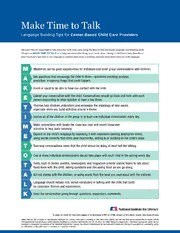
ERIC ED511968: Make Time to Talk: Language Building Tips for Center-Based Child Care Providers PDF
Preview ERIC ED511968: Make Time to Talk: Language Building Tips for Center-Based Child Care Providers
Make Time to Talk Language Building Tips for Center-Based Child Care Providers MAKE TIME TO TALK We know that it’s important to talk every day with each child, using the kind of talk that builds language and thinking skills. The phrase is to help you remember things you can do when talking to children to help them learn new vocabulary and how to use language to express their ideas and needs, and that helps them have fun with language. Mealtimes can be good opportunities for individual and small group conversations with children. Ask questions that encourage the child to think—questions involving analysis, prediction, imagining things that could happen. Kneel or squat to be able to have eye contact with the child. Extend your conversation with the child. Conversations should go back and forth with each person responding to other speaker at least a few times. Themes help children understand and remember the meanings of new words, especially when you build activities around a theme. Involve all of the children in the group in at least one individual conversation every day. Make connections with books the class has read and recent classroom activities to help build meaning. Expand on the child’s language by repeating it with extensions (adding descriptive words, using words correctly that child used incorrectly), adding to or building on the child’s ideas. Two-way conversations mean that the child should be doing at least half the talking. One or more individual conversations should take place with each child in the setting every day. Texts, such as books, posters, newspapers, and magazines provide shared topics to talk about. Read them with the child, asking questions and discussing them as you go along. Act out stories with the children, re-using words from the book you read aloud with the children. Language should include rich, varied vocabulary in talking with the child that build on classroom themes and experiences. Keep the conversation going through questions, expansions, comments. To place an order for free print copies or to download a PDF or HTML version of this sheet, please visit www.nifl.gov. Make Time to Talk is based on the National Institute for Literacy publication Learning to Talk and Listen (2009), and the National Early Literacy Panel Report (2009). This publication was produced under National Institute for Literacy Contract No. ED-04-CO-0041 for RMC Research Corporation. The views expressed herein do not necessarily represent the policies of the National Institute for Literacy. No official endorsement by the National Institute for Literacy of any product, commodity, entity, or enterprise in this publication is intended or should be inferred. Make Time to Talk Language Building Tips for Home-Based Child Care Providers MAKE TIME TO TALK We know that it’s important to talk every day with each child, using the kind of talk that builds language and thinking skills. The phrase is to help you remember things you can do when talking to children to help them learn new words and how to use language to tell you their ideas and needs, and that helps them have fun with language. Mealtimes can be good times to talk with children. Ask questions that encourage the child to think—questions involving predicting things that might happen, using imagination, explaining why things happened in a particular way. Kneel or squat to be able to have eye contact with the child. Extend your conversation with the child. Conversations should go back and forth with each person responding to other speaker at least a few times. Tell stories to the children and ask them to tell you stories about their families and lives. Involve all of the children in the group in conversation every day. Talk with children about what they are making, ask about their play. Make connections between themes, books the class has read, recent classroom activities, and children’s own play to help build children’s understanding of word meanings. Expand on child’s language by repeating it with extensions (adding descriptive words, using any words correctly that child used incorrectly), adding to or building on child’s ideas. Two-way conversations are best. The child should be doing at least half the talking. One or more individual conversations with each child in the setting every day should be a goal. Texts such as books, posters, newspapers, and magazines provide things to talk about with children. Read them together, asking questions and discussing them as you go along. Act out stories with the children, re-using words from a book you read aloud with the children. Encourage them to retell the story with puppets, toys, and in their art. Language should include rich, varied words that you want the child to learn to understand and use. Keep the conversation going through questions and comments. To place an order for free print copies or to download a PDF or HTML version of this sheet, please visit www.nifl.gov. Make Time to Talk is based on the National Institute for Literacy publication Learning to Talk and Listen (2009), and the National Early Literacy Panel Report (2009). This publication was produced under National Institute for Literacy Contract No. ED-04-CO-0041 for RMC Research Corporation. The views expressed herein do not necessarily represent the policies of the National Institute for Literacy. No official endorsement by the National Institute for Literacy of any product, commodity, entity, or enterprise in this publication is intended or should be inferred.
